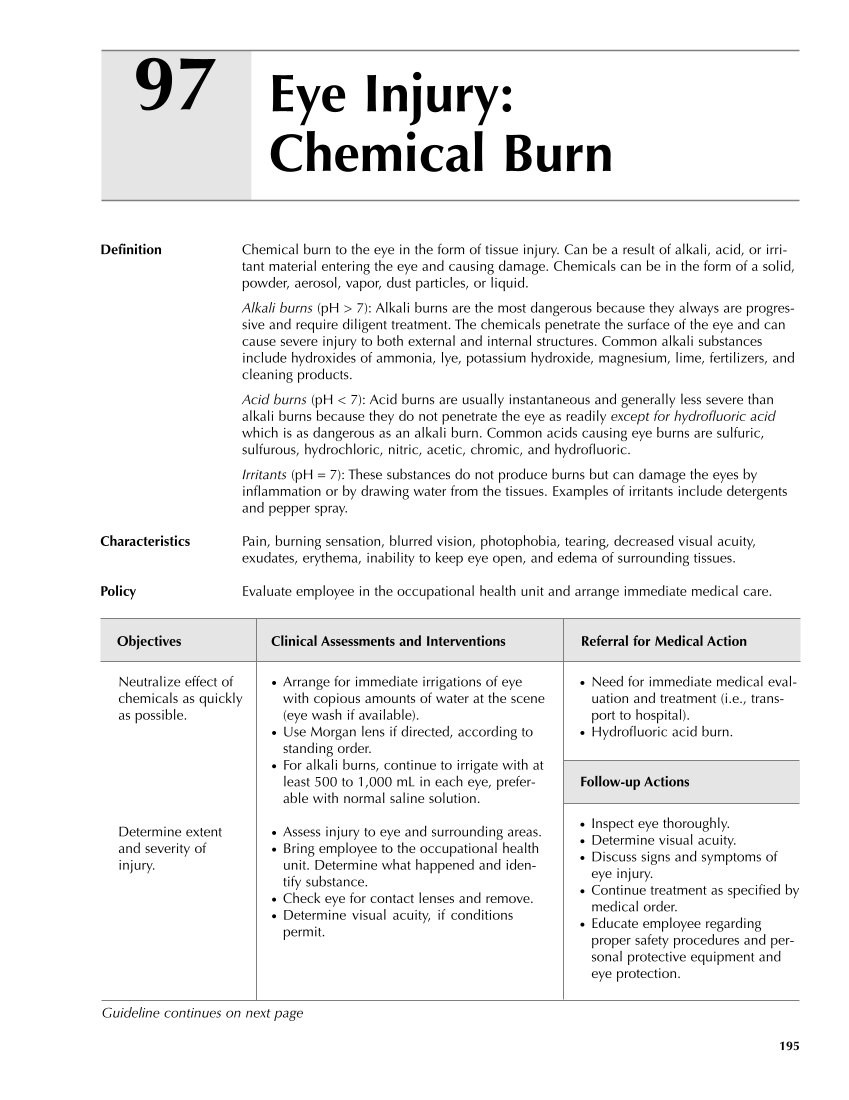● Need for immediate medical eval- uation and treatment (i.e., trans- port to hospital). ● Hydrofluoric acid burn. Follow-up Actions ● Inspect eye thoroughly. ● Determine visual acuity. ● Discuss signs and symptoms of eye injury. ● Continue treatment as specified by medical order. ● Educate employee regarding proper safety procedures and per- sonal protective equipment and eye protection. Neutralize effect of chemicals as quickly as possible. Determine extent and severity of injury. ● Arrange for immediate irrigations of eye with copious amounts of water at the scene (eye wash if available). ● Use Morgan lens if directed, according to standing order. ● For alkali burns, continue to irrigate with at least 500 to 1,000 mL in each eye, prefer- able with normal saline solution. ● Assess injury to eye and surrounding areas. ● Bring employee to the occupational health unit. Determine what happened and iden- tify substance. ● Check eye for contact lenses and remove. ● Determine visual acuity, if conditions permit. 195 Eye Injury: Chemical Burn 97 Definition Chemical burn to the eye in the form of tissue injury. Can be a result of alkali, acid, or irri- tant material entering the eye and causing damage. Chemicals can be in the form of a solid, powder, aerosol, vapor, dust particles, or liquid. Alkali burns (pH 7): Alkali burns are the most dangerous because they always are progres- sive and require diligent treatment. The chemicals penetrate the surface of the eye and can cause severe injury to both external and internal structures. Common alkali substances include hydroxides of ammonia, lye, potassium hydroxide, magnesium, lime, fertilizers, and cleaning products. Acid burns (pH 7): Acid burns are usually instantaneous and generally less severe than alkali burns because they do not penetrate the eye as readily except for hydrofluoric acid which is as dangerous as an alkali burn. Common acids causing eye burns are sulfuric, sulfurous, hydrochloric, nitric, acetic, chromic, and hydrofluoric. Irritants (pH = 7): These substances do not produce burns but can damage the eyes by inflammation or by drawing water from the tissues. Examples of irritants include detergents and pepper spray. Characteristics Pain, burning sensation, blurred vision, photophobia, tearing, decreased visual acuity, exudates, erythema, inability to keep eye open, and edema of surrounding tissues. Policy Evaluate employee in the occupational health unit and arrange immediate medical care. Objectives Clinical Assessments and Interventions Referral for Medical Action Guideline continues on next page
Purchased from OEM Press by (ge corporate access). (C) 2013 OEM Health Information, Inc. All rights reserved.












































































































































































































































































































































































































































